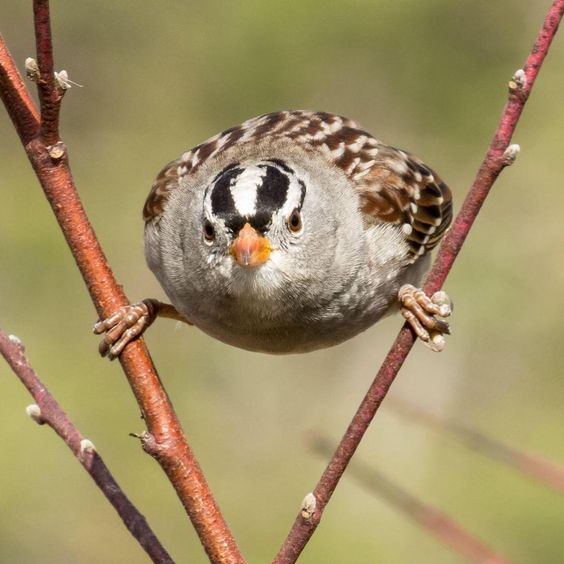SAN FRANCISCO—On Thursday, September 24, Science Magazine published a study chronicling improved songs of San Francisco’s white-crowned sparrow amongst the “half-century soundscape reversion” of the COVID-19 shutdown.
The study states noise levels in urban areas were sustainably lowered during the shutdown, mimicking the sounds of motor vehicle traffic in the mid-1950s. Reduction in traffic is cited as a potential alleviation of auditory pressures on animals that rely on sound for survival and reproduction, such as the white-crowned sparrow, which during shutdown was found to produce “higher performance songs at lower amplitudes, effectively maximizing communication distance and salience.”
The species was proven to have benefitted from the newly emptied acoustic space in the San Francisco Bay Area through the comparison of soundscapes and songs prior to California’s shutdown, April to June 2015 and 2016, and shortly after execution of statewide shelter-at-home mandates, April to May 2020. These results abide to the study’s theory suggesting “animals should respond to reduced background noise by altering their acoustic signals to optimize the transmission of information.”
The findings presented an unprecedented opportunity to study the effect of human behavior on soundscapes and animal acoustic behaviors, as well as animals’ resilient to man-made pressures such as sound pollution.
Data was collected in both urban areas, in San Francisco and Contra Costa County, and more rural areas, in Marin County. Before shutdown, white-crowned sparrow song varied in urban and rural areas predictably, with louder, lower quality song observed within cities.
The study relies on the fact that urban soundscapes exhibit more sound energy, at low frequencies, which occurs with greater traffic flow. Birds in such breeding territories sing higher amplitude songs with higher minimum frequencies, “a common response to noise known as the Lombard effect,” which states volume (amplitude) increases with pitch (frequency). Prior to shutdown, urban white-crowned sparrow breeding territories were on average almost three times as loud as rural territories.
During the shutdown, background noise was “dramatically lowered” in urban territories, but not as much in rural territories.
“This is consistent with the observation that traffic is a primary source of background noise across urban San Francisco, whereas the ocean and wind generate background noise in nearby rural Marin County,” according to the study. During shutdown, urban and rural soundscapes exhibited the same noise level. “Like the half-century soundscape reversion that occurred in more urban areas of the study region, some bird songs exhibited traits, such as trill minimum frequency, during the shutdown that have not been heard in decades.”
The study summarized negative effects of pre-shutdown sparrow song, writing that male sparrows that sing at higher minimum frequency often have lower vocal performance and are unable to produce rapid trills at wide frequencies, rendering them less competitive in male-to-male competitive interactions which occur when males defend territories. The study asserts, “Accordingly, if noise levels decline, males should produce songs at lower amplitudes and lower minimum frequencies, thereby increasing communication distance while also allowing for higher vocal performance.”
While the birds sang more softly during the shutdown, communication distance more than doubled which “could elevate fitness by reducing territorial conflicts and increasing mating potential.” The study reported the signal-to-noise ratio (SNR) throughout the studied locations doubled in relative energy, explaining media reports saying bird songs sounded louder during the shutdown.
The study states actions taken to reduce the threats of COVID-19, including elective quarantine, stay-at-home orders, and to limit the use of transportation networks and public spaces, which have inadvertently resulted in new landscapes for wildlife. This was observed early in San Francisco by behavioral ecologist Elizabeth P. Derryberry when, two weeks into mandatory stay-at-home orders, coyotes encroached on city neighborhoods and even crossed the Golden Gate Bridge. For over a decade, Derryberry studied the white-crowned sparrow and the detrimental effect of urban noise on the species’ ability to communicate. She was the first mentioned writer of the published study, among colleagues Jennifer N. Phillips, Graham E. Derryberry, Michael J. Blum, and David Luther.
The study concluded that, “Our findings indicate that songbirds like white-crowned sparrows have a striking capacity to exploit newly empty soundscapes following acute but ephemeral amelioration of noise pollution, suggesting that lasting remediation might engender even more promising outcomes, such as demographic recovery and higher species diversity in urban areas. Our findings illustrate that rapid recovery is possible despite long-standing legacies of chronic exposure, akin to responses that have been observed following the cessation of chemical pollution that persists in the environment.”






